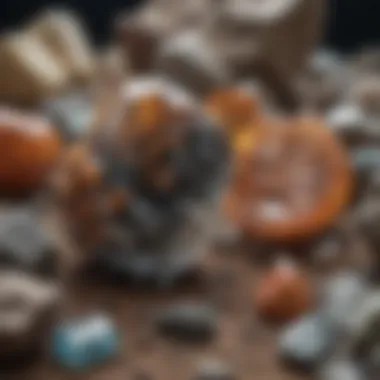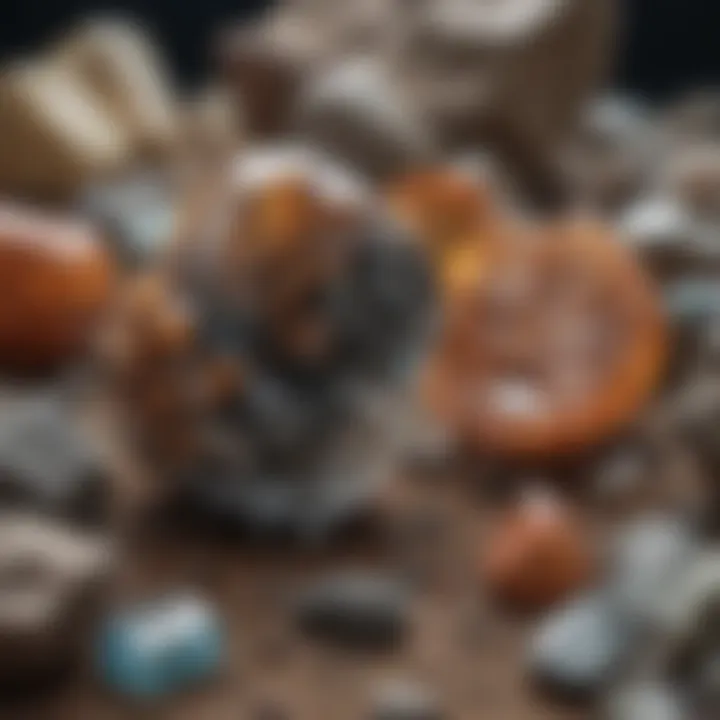Mastering Crystal and Mineral Identification Techniques


Intro
Identifying crystals and minerals is not just a hobby for enthusiasts; it's a gateway into the astonishing world of Earth’s geological displays. From the shimmering facets of quartz to the rich hues of malachite, understanding what makes these specimens tick can heighten one’s appreciation and collection. But where does one even begin on this quest for knowledge? This article seeks to clarify the essential techniques behind crystal and mineral identification, while offering practical tips, resources, and a peek into the ecosystem of collectors.
The significance of being able to recognize and classify various types can’t be stressed enough, especially for those whose love for geology extends beyond casual interest. It connects collectors to the rich history of our planet, while also enhancing the science of gemology, where crsytals are not merely stones, but stories waiting to be told.
Now, let’s begin by featuring a unique collectible that exemplifies what makes mineral identification exciting and rewarding.
Featured Collectible of the Month
Overview
This month, our star collectible is the Kyanite, a striking blue mineral often found in metamorphic rocks. With its distinctive blade-like crystals that can range from deep sapphire to pale sky blue, kyanite stands out in any display. It provides an excellent opportunity for collectors to delve into the various identification techniques available, given that kyanite can be somewhat tricky due to its variable hardness along different crystal axes.
Historical Significance
Kyanite has been celebrated since ancient times, frequently used by artisans in jewelry and tools. Ancient civilizations believed that kyanite held metaphysical properties, claiming it fostered harmony and balance. This belief often drove trade routes, where kyanite was exchanged for other valuables. Today, its allure still captivates hobbyists worldwide, making it a must-have for any serious collection.
"Every mineral tells a story of time, pressure, and change. Understanding these stories enhances our connection to the Earth."
Identification Techniques
Understanding how to accurately identify minerals and crystals involves a combination of keen observation and scientific analysis. Here are some essential techniques that every collector should master:
Visual Characteristics
When you first encounter a new specimen, pay close attention to its visual traits. Consider the following aspects:
- Color: This is often the first thing that catches the eye, but don't rely on it alone.
- Luster: Whether it’s dull, glossy, or metallic can significantly aid in identification.
- Crystal Form: Familiarize yourself with common crystal shapes like cubic or prismatic formations.
- Cleavage and Fracture: Observe how a mineral breaks—this can be a reliable feature for identification.
- Transparency: Determine if the specimen is transparent, translucent, or opaque.
Resources for Identification
A variety of resources can assist you further in your identification journey:
- Field Guides: Books like The National Audubon Society Field Guide to North American Rocks and Minerals are invaluable for on-the-spot identification.
- Gemological Laboratories: Places like the Gemological Institute of America provide advanced courses that can deepen your expertise.
- Online Communities: Platforms like Reddit and various Facebook groups serve as great places to share knowledge and ask questions.
- YouTube Tutorials: Visual content can break down complicated techniques in an easily digestible format.
In wrapping up this section, it's vital to underscore that a commitment to learning about crystal and mineral identification will not only enrich your collection but also sharpen your eye for the unique beauty of the earth's treasures. Whether you’re scouting for rare specimens or simply admiring their intricacies, the journey of understanding is as valuable as the specimens themselves.
Intro to Crystal and Mineral Identification
The art and science of crystal and mineral identification is a fascinating journey into the depths of natural history. The ability to discern between various types of minerals and crystals can substantially enhance one’s appreciation and understanding of geology and gemology. This section aims to lay the groundwork for grasping the significance of identification by examining its importance and tracing the historical methods that have shaped our current practices.
Importance of Identification
Identifying crystals and minerals carries substantial weight not just for enthusiasts, but also for professionals in various fields. Such identification allows collectors to classify their specimens correctly, enhancing their value and preserving their significance. Additionally, it serves several essential purposes:
- Scientific Research: Accurate identification is pivotal for geological studies, enabling researchers to draw conclusions related to the Earth's history and formation.
- Collection Value: Knowing exactly what one has adds layers to the monetary and sentimental value of crystal collections.
- Practical Uses: Beyond emotional ties, many minerals have industrial applications, meaning identification can lead to practical solutions in fields ranging from construction to electronics.
- Education: For educators and students alike, a solid foundation in this area forms a crucial link between theory and hands-on learning.
The importance of identifying crystals and minerals stretches well beyond casual interest; it entwines itself with our understanding of Earth's resources and natural beauty.
Historical Context
The journey of crystal and mineral identification began long before modern science took form. Understanding how early attempts translate into current methodologies reveals much about our evolving relationship with the Earth.
Early Methods
In ancient times, the identification of minerals was often a blend of observation and superstition. For example, the Greeks used color and luster as primary characteristics for distinction. They grouped minerals based mainly on their visual traits. This rudimentary method, while simplistic, laid essential groundwork for future identification techniques. One key characteristic was a reliance on physical attributes such as:
- Color: Initial identification often hinged on what the eye could see.
- Texture: The feel of a specimen was another tell-tale sign.
These early methods were both beneficial and limiting. Their advantages resided in their accessibility; anyone could observe colors and textures without needing advanced tools. However, the major disadvantage was the subjective nature of visual assessments, often leading to confusion as many minerals bore similar appearances.
Evolution of Techniques
The evolution from primitive methods to more advanced techniques of mineral identification marks a pivotal shift in our scientific approach. Around the 19th century, techniques began to advance considerably. The introduction of tools such as the hand lens and, later, polarized light microscopes transformed the sector. One significant aspect of this evolution is the establishment of systematic classifications rooted in chemical composition rather than solely on appearance.
This transition allowed for a more nuanced understanding of minerals. Key characteristics that defined this phase included:
- Adoption of Chemical Analysis: Scientists began to study the chemical make-up, which led to more accurate classifications.
- Development of Systematic Classifications: Moving from a solely aesthetic approach to a systematic, scientific endeavor greatly enriched the field.
While these advancements introduced greater precision, they also required more specialized knowledge and access to tools, thus raising barriers for casual enthusiasts. Overall, the evolution of techniques became a double-edged sword, where newfound accuracy came at the cost of accessibility.
Basic Properties of Minerals
Understanding the basic properties of minerals serves as a foundation in the field of crystal and mineral identification. These properties help collectors, hobbyists, and researchers understand not just what they are looking at, but also give insights into the mineral's origins and potential uses. Each mineral showcases a unique combination of characteristics that are essential for accurate classification and understanding. By grasping these essential traits, one can embark on a more informed exploration of the natural world.
Physical Properties
Color
When it comes to color, it often serves as the first thing that catches the eye, making it an important identifier. Color can vary dramatically between minerals due to impurities, defects, and the crystal lattice structure. For instance, fluorite can occur in shades of purple, green, or yellow, which can confuse those not well-versed in its identification. Its colorful display makes color a beneficial point for identification at a glance, but it can also be misleading. Some minerals share similar colors, complicating the identification process. The unique aspect of color, therefore, is its variability, which possesses both benefits and pitfalls in identification endeavors.
Luster
Luster pertains to how light interacts with a mineral's surface. It can range from shiny, metallic finishes to dull, earthy appearances. Properties like metallic, glassy, or dull can convey a wealth of information about a mineral's composition. For example, galena has a metallic luster that distinguishes it from many others with less reflective qualities. This becomes a crucial identification characteristic, especially in the field where shiny specimens can stand out against a backdrop of dull ones. Still, this factor isn't without its own unique challenges – similar lusters can make distinguishing between minerals tricky.
Hardness
Hardness is measured using the Mohs hardness scale, which ranges from talc (softest) to diamond (hardest). The resistance of a mineral to scratching can reveal vital clues about its identity. For example, quartz, with a hardness rating of 7, can scratch glass, which many collectors use as a simple field test. Hardness is particularly pivotal as it allows for practical tests that can be performed even outside of a laboratory setting. However, relying solely on hardness could lead to errors, since not every collector has the same means of testing, and some minerals may not have distinctive hardness levels easily observed in the field.


Chemical Composition
Elemental Analysis
Elemental analysis explores the specific chemical constituents of a mineral. By identifying the various elements within a mineral, one can determine its overall composition and potential categorization. This technique can offer deep insights into a mineral's origin, stability under different environmental conditions, and even its various uses across industries. It’s an essential tool for serious mineralogists and provides a more scientific basis that complements visual or physical tests. However, equipment for elemental analysis may not always be accessible to the average enthusiast, which can limit practical use to those with laboratory access.
Mineral Formula
The mineral formula succinctly represents the composition of a mineral, specifying the ratio of its constituent elements. For instance, the formula for quartz is SiO2, revealing it contains one silicon atom and two oxygen atoms. This clarity helps provide critical context around the mineral in terms of both identification and understanding its properties. However, as beneficial as formulas can be, the nature of some minerals lends them to variations, which can create confusion when misidentifying similar-looking minerals that have different formulas.
Crystal Habit and Structure
Types of Crystals
The type of crystal can significantly aid in identification efforts. Minerals can crystallize in various forms—cubic, hexagonal, and octahedral, to name a few. Each form suggests particular growth patterns and environmental conditions under which the mineral formed. Recognizing these characteristics can lead to clearer identification, as certain minerals are known to crystallize in specific forms. For example, pyrite often adopts a cubic habit, providing a quick visual cue that can distinguish it from other gold-like minerals. But this comes with the downside that not all specimens show their crystal habit well, especially in massive forms.
Growth Patterns
Crystal growth patterns refer to the way minerals grow and form their final shapes. This often provides clues about the conditions present during their formation, such as temperature, pressure, and the minerals involved. For example, some crystals may show striations or grooves that indicate how they grew in layers. Understanding these patterns can benefit collectors looking to identify their specimens more accurately, revealing stories about their geologic history. However, deciphering growth patterns may require advanced knowledge, making it more challenging for novice collectors to grasp.
Understanding these basic properties can turn mineral identification from a guessing game into a rich journey of discovery. The traits of minerals are not just static indicators; they speak volumes about Earth’s geological processes and history, making them a rewarding subject for anyone interested in this natural art form.
By delving into the intricacies of these characteristics, collectors can enhance their practice and develop a more nuanced understanding of the minerals in their collection.
Methods of Identification
Understanding the methods of identifying crystals and minerals is crucial for both hobbyists and serious collectors. These techniques provide the tools necessary to accurately evaluate specimens and gain insights into their characteristics. Whether relying on simple visual cues or advanced laboratory equipment, each method has its own strengths and offers different levels of accuracy. By knowing which techniques to use, collectors can enhance their skills, validate their finds, and deepen their appreciation for the beauty and complexity of the natural world.
Field Identification Techniques
Visual Assessment
Visual assessment is often the first step in identifying a mineral or crystal. This method involves examining color, luster, and even texture just by looking at the specimen. The key characteristic is immediacy; collectors can quickly gain insights without the need for sophisticated tools. This makes it a popular choice for fieldwork where conditions may not allow for more complex analyses.
A unique feature of visual assessment lies in its ability to draw on one's experience and intuition. However, it's worth mentioning that this method can be somewhat subjective. Factors such as lighting or the presence of other minerals can lead to misinterpretation. Thus, while useful, it's best not to rely on it solely for concluding.
Field Tests
Field tests take visual assessment a step further by involving hands-on methods to determine a mineral's properties. For example, streak tests, hardness tests using the Mohs scale, and even acid tests can provide a clearer picture of what one is examining. The major benefit of field tests is that they are practical, enabling collectors to confirm their initial observations against measurable characteristics.
What sets field tests apart is their tactile engagement and direct interaction with the specimen. However, there are limitations. Not all tests are applicable to every type of mineral, and misidentification can still occur if the test is misapplied. It's important to have a basic understanding of these tests or consult experts when necessary.
Laboratory Techniques
X-Ray Diffraction
X-ray diffraction is a highly precise laboratory technique used to identify crystalline materials. By analyzing the patterns produced when X-rays are aimed at a mineral sample, experts can derive intricate details about the crystal structure. This method is particularly beneficial because it offers a level of accuracy that is unattainable through field techniques alone.
The unique aspect of X-ray diffraction is its ability to differentiate between minerals that may appear similar to the naked eye. However, the disadvantages are notable as well; it requires specialized equipment and expertise, making it less accessible to casual collectors.
Spectroscopy
Spectroscopy involves studying how a mineral interacts with various forms of electromagnetic radiation. This can range from visible light to infrared or even UV radiation. The key characteristic of spectroscopy is its ability to provide an in-depth chemical analysis, revealing elements present within the mineral. Collecting this kind of data can be invaluable for understanding the mineral’s origins and properties.
One of the unique advantages of spectroscopy is its non-destructive nature, meaning that the specimen can be preserved for further studies. However, like X-ray diffraction, spectroscopy requires advanced equipment and may not be available for all enthusiasts or in field situations.
Technological Advances
Digital Tools
The rise of digital tools has transformed how collectors approach mineral identification. Software applications can analyze photographs and offer possible identifications based on visual data. These tools are beneficial because they allow for a broader range of analysis, even enabling users to connect with databases of minerals for quicker learning.
A unique feature of digital tools is their ease of use. However, reliance on technology may lead to overconfidence. Hands-on experience remains irreplaceable, as digital tools can sometimes provide inaccurate readings based on unclear images or poor data.
Mobile Applications
Mobile applications serve as handy companions in the field. Several apps can assist with identification through camera functionalities, and some even offer augmented reality features. They are particularly useful for on-site analysis, offering instant access to databases and resources.
These applications are a game changer because they equip users with tools they would otherwise have to carry in a bulky field kit. However, the downside is that app reliability can vary. Not all apps have the same depth of data or accuracy, leading users to potentially misidentify specimens unless they cross-reference with established resources.
In summary, the methods of identification play a pivotal role in understanding crystals and minerals. Each technique, whether field-based or laboratory-focused, serves its purpose and can lead to more informed and enriching collecting experiences.
Crystal and Mineral Classification Systems
Understanding the classification systems for crystals and minerals is crucial in the realm of identification. These systems help enthusiasts and professionals alike to categorize specimens, making communication and study much easier. Each classification serves as a sort of roadmap, guiding collectors toward a deeper understanding of different minerals’ origins, structures, and characteristics.
By organizing minerals into specific groups based on shared traits, collectors can not only appreciate the beauty of these natural forms but also gain insights into their formation processes and potential uses. Moreover, consistent classification promotes standards in communication among collectors, facilitators, and academics, ensuring accurate discussions about mineral properties and identification techniques.
More importantly, classification systems provide a useful framework for education. For beginners, familiarizing themselves with these systems lays a strong foundation for further exploration into geology and gemology.
The Mohs Hardness Scale
The Mohs hardness scale is a fundamental classification tool used by mineralogists to determine the relative hardness of minerals. This scale ranks ten minerals from 1 to 10, with talc sitting at the bottom as the softest, and diamond at the pinnacle as the hardest. Understanding this scale is not just about memorizing numbers; it’s about applying this knowledge during field identification or in a resale context. The scale helps hobbyists determine how a specimen might react to scratches, an important characteristic for identifying and distinguishing minerals.
Adopting this scale simplifies discussions and comparisons, whether they're taking place at a collector’s meeting or at an educational workshop. It becomes quite handy as both a practical tool and a concept to grasp, particularly for newcomers aiming to ascertain the durability and potential applications of various minerals.
Mineral Groups Overview
In the mineral kingdom, classification doesn’t stop at hardness. It expands into various groups, each with their unique properties and significance. Here’s a closer look:
Silicates


Silicates, making up about 90% of the Earth's crust, are acknowledged for their complex structures consisting of silicon and oxygen. They form various minerals, such as quartz and feldspar, which are not only common but also crucial in geology. The key characteristic of silicates lies in their tetrahedral arrangement of silicon and oxygen atoms, creating an immense variety of structures.
This diversity means silicates offer a wealth of options for identification and utilization in various applications—from construction materials to electronics. However, navigating through the vast silicate family can prove challenging due to similarities in appearance, making proper classification essential.
Carbonates
Carbonates, primarily composed of carbon and oxygen, represent another significant mineral family. They include well-known minerals like calcite and aragonite. Their characteristic behavior in acidic environments, where they fizz or effervesce, provides a straightforward method for identification, making them an approachable subject for enthusiasts.
This fizzing reaction is a unique feature that aids in distinguishing carbonates from other minerals and contributes to their appeal in both geological studies and practical uses such as in cement production. However, collectors must be cautious as some carbonates can resemble other non-carbonate minerals.
Oxides
The oxides are defined by their structure and composition, comprising oxygen along with one or more metals. Minerals like hematite and magnetite fall into this category. Their key characteristic is their metallic luster and often dense nature, which can be striking. Oxides have been widely used, particularly in metallurgy and electronics, making their identification critical for various industries.
Recognizing the distinctive features of oxides enables collectors to identify and assess their value effectively. However, their appearance can sometimes overlap with silicates, which may lead to potential misidentification.
Sulfates
Sulfates are chemically defined by the sulfate ion (SO4) and include minerals like gypsum and barite. They can often be identified by their solubility in water and unique crystal habits. For collectors, the key characteristic of sulfates is their ability to form relatively large and well-defined crystals, making them visually appealing.
While their usefulness in construction and agriculture is well-documented, enthusiasts should take care with sulfates as they can be more delicate compared to other mineral families. Hence, understanding their properties is essential for ensuring proper handling and preservation.
Common Crystals and Minerals
Understanding common crystals and minerals is a cornerstone for anyone delving into the realm of crystal and mineral identification. This knowledge is not merely academic; it lays the groundwork for practical applications in fields ranging from geology to gemology. Moreover, recognizing these minerals sharpens one’s observation skills, fostering a more profound appreciation for Earth's natural treasures.
Familiarity with common specimens enhances collection efforts, propelling hobbyists toward a more fruitful and enjoyable pursuit. Specific elements such as visual recognition, comprehension of unique properties, and historical significance elevate the importance of these crystals and minerals in identification practice. From quartz to calcite, knowing their characteristics is vital, as these minerals frequently surface in the field and laboratories alike.
Quartz
Quartz is, without a doubt, one of the most abundant minerals on Earth. Its prevalence makes it a staple for collectors and hobbyists. Known for its impressive hardness, quartz ranks a solid seven on the Mohs scale, ensuring its durability under various conditions. Its clear, crystalline form, combined with an array of colors—like smoky, rose, and amethyst—adds to its allure.
In practical terms, quartz's versatility lends itself to numerous applications. Beyond just gemology, it plays a significant role in technology, finding its way into watches, electronics, and even glassmaking. Understanding quartz means tapping into its rich geological history, opening new doors for enthusiasts.
Calcite
Calcite is another mineral that cannot be overlooked in mineral identification. Found in sedimentary rocks like limestone, it's recognized for its stunning variety of colors and effective reaction to acids. A highlight of calcite is its ability to double refract light, creating fascinating visual effects.
For collectors, calcite is a two-for-one deal: not only is it beautiful, but it's also abundant. This means collectors can often find excellent specimens that don’t break the bank. However, its softness—ranking between three and four on the Mohs scale—means care is needed to preserve its pristine quality, especially in the field.
Fluorite
Fluorite dazzles with its vibrant range of colors, from deep greens to soothing lilacs. Most significantly, it glows under ultraviolet light, making it a true showstopper for collectors and enthusiasts. Its cubic structure and fluorescent properties distinguish it from many other minerals, providing both aesthetic appeal and a unique identification point.
When discussing its applications, fluorite is not just a pretty face. It serves important industrial roles, notably in the manufacturing process for aluminum and certain types of glasses. Its varied forms and genuine beauty make it a hot commodity among collectors.
Other Notable Examples
Amethyst
Amethyst stands out as a popular choice for collectors. This purple variety of quartz is appreciated for its stunning hues and strong historical connections with royalty and spirituality. Its calming properties are widely touted in metaphysical circles, lending it an added layer of intrigue. The key characteristic of amethyst is its rich color, which can range from pale lavender to deep violet.
What makes it particularly interesting is its formation; amethyst typically develops in geodes, creating a striking appearance once cracked open. The strategic use of amethyst in jewelry and home decor makes it not only visually appealing but also a sought-after item in the market.
Pyrite
While often mistaken for gold due to its shiny, metallic luster, pyrite holds its own significance. Known as “fool's gold,” pyrite is celebrated for its unique cubic crystals and ability to generate sparks when struck. This mineral serves a dual purpose; it’s both captivating in appearance and widely used in the industry, especially in the production of sulfuric acid.
In the context of our exploration, pyrite's distinct characteristic of forming in fool's gold-like clusters can aid in distinguishing it from other minerals. This fascination with how it tricks the eye also appeals to collectors who enjoy the story behind their specimens.
Mica
Mica is renowned for its layered structure and flexible sheets. It's commonly found in a variety of rock types and often comes in brilliant shades of gold or silver. Its key characteristic lies in its ability to split into thin sheets, making it a favorite among collectors for various applications ranging from insulation to crafting.
Moreover, mica can be easily identified due to its unique shiny appearance and transparency. Its combination of beauty and practicality positions mica as an invaluable mineral for enthusiasts who appreciate both its aesthetic allure and functional benefits.
Understanding these common crystals and minerals equips collectors with the skills necessary to navigate their identification journey confidently. With each mineral comes a story, a unique characteristic, and the promise of deeper insights into the natural world.
Practical Applications of Identification
The field of crystal and mineral identification does not just serve hobbyists; it shapes multiple aspects of our daily lives, industries, and educational frameworks. Understanding these practical applications allows individuals, whether novices or seasoned collectors, to appreciate the nuances and utilize their knowledge effectively. By diving into this realm, one can see how identification skills promote sustainability, enable informed practices, and cultivate a deeper connection with the Earth’s materials.
Collecting and Preservation
Collecting crystals and minerals goes beyond simply placing specimens in a box; it’s about ensuring their longevity and maintaining their integrity. Proper identification is key to this process. With a grasp of each specimen’s properties, collectors can choose the right preservation techniques.
Aspects to consider include:
- Humidity Control: Some minerals are hygroscopic, meaning they absorb moisture from the air. Proper storage in airtight containers can minimize degradation.
- Temperature Stability: Rapid temperature changes can cause thermal shock in certain crystals. Maintaining a consistent environment helps preserve their structural integrity.
- UV Protection: Some minerals, like fluorite, can fade when exposed to direct sunlight over extended periods. Utilizing display cases with UV-filtering glass can protect these beauties.
"Preserving crystals is like maintaining a fine piece of art; it requires care, dedication, and respect for the material's uniqueness."
This brings an added dimension to collecting, as knowledge translates into better stewardship of natural resources. Collectors who understand the nuances of their specimens can avoid the pitfalls that come with neglect or mishandling.
Educational Uses
Crystal and mineral identification plays a vital role in education, from geology classes to primary school science fairs. Engaging with these materials fosters scientific literacy and ignites curiosity among students.
Benefits of incorporating crystal and mineral studies include:


- Hands-on Learning: Students can develop practical skills by identifying minerals and understanding their properties in real time.
- Interdisciplinary Connections: Lessons can tie into chemistry, environmental science, and even art. For instance, students might explore how geology impacts local economies, or how crystals inspire artistic expression.
- Encouraging Scientific Inquiry: Students are prompted to ask questions about the world around them, leveraging these inquiries into larger educational themes.
In classrooms, crystal and mineral identification serves as a bridge to broader concepts, encouraging an appreciation for natural sciences. It helps build a foundational understanding that can translate into lifelong learning and exploration.
Industrial Applications
The practical applications of crystals and minerals extend significantly into various industries. Many real-world uses rely on the unique properties of these materials to create products or technologies.
Several key industries include:
- Electronics: Quartz is essential in the production of frequency control devices and watches, showcasing how mineral properties directly impact technology.
- Construction: Minerals like gypsum and limestone are not just decorative stones; they are fundamental in cement production, shaping the built environment.
- Healthcare: Certain minerals are utilized in medical imaging and diagnostic tools. For example, barite is used in radiology due to its density.
By identifying and understanding these materials, manufacturers can streamline processes and increase product efficacy. This knowledge ultimately drives innovation and promotes sustainable practices, as industries work towards minimizing waste and maximizing the utility of natural resources.
Overall, the practical applications of crystal and mineral identification demonstrate its relevance beyond individual interests. By attending to the various benefits and considerations associated with this knowledge, one can appreciate the significant role minerals and crystals play in both local and global contexts.
Challenges in Identification
Identifying crystals and minerals can often feel like trying to solve a jigsaw puzzle with missing pieces. The intricate nature of these specimens, combined with their varied forms, textures, and colors, presents unique challenges for collectors and enthusiasts alike. This section sheds light on two primary issues: identification confusion and environmental factors that can complicate matters further.
Identification Confusion
The path to accurate mineral identification is often fogged by several factors. A key element contributing to this confusion is the phenomenon of similar colors. In the colorful world of minerals, it’s easy to see why this particular aspect can trip up even the seasoned eye. Take, for instance, the striking greens of serpentine and jade. From a distance, they appear almost indistinguishable. This characteristic of similar colors presents both a challenge and an opportunity. On one hand, it can lead to misidentification; on the other, it encourages a deeper dive into mineralogy. When collectors assume a specimen's identity based solely on color, they risk the misstep of overlooking vital details that can guide them towards a correct identification.
A notable advantage of understanding similar colors lies in the depth it gives to one's skill set. Being able to discern the subtle nuances that differentiate minerals can enhance the joy of collecting. However, this does demand astute observation and knowledge of detailed mineral characteristics beyond mere appearance, such as hardness and luster.
Overlapping Characteristics
Similar to colors, the overlapping characteristics of minerals present another hurdle. Different minerals can exhibit comparable physical traits, like crystal habit or fracture patterns, which can blur the lines during identification. For example, the resemblance between calcite and aragonite can befuddle even experienced geologists. Both share common features, yet their chemical compositions and crystalline structures diverge significantly.
The overlap can be both a bane and a boon. On one hand, it poses challenges as it requires meticulous examination and sometimes advanced techniques for a decisive identification. On the other hand, understanding these overlapping characteristics can broaden one’s knowledge and appreciation for mineral complexities. It allows for systematic differentiation, which is essential for collectors aiming for precision in their collections.
Environmental Factors
Environmental factors also play a crucial role in the identification process. The geographic location of a mineral specimen, along with the conditions under which it formed, can influence its characteristics. For example, minerals found in metamorphic environments may exhibit unique textures not seen in those from igneous origins.
Additionally, weathering and exposure can alter surface features, creating challenges for categorization. Such transformations remind collectors that their specimens are not static, but continuing narratives of geological processes at work. Therefore, a thorough understanding of the environment surrounding a mineral is paramount, as it can offer insights into the identifiers of the specimen.
"When dealing with nature's handiwork, understanding its context is as important as identifying its essence."
In summary, navigating the challenges of mineral identification requires keen observation, an understanding of nuanced characteristics, and an awareness of environmental influences. Collectors who engage deeply with these complexities can elevate their practice from mere collection to true appreciation of the intricacies of geology.
The Role of Community in Identification
In the ever-evolving world of crystal and mineral identification, the community plays a pivotal role. The shared passion among enthusiasts fosters an environment where knowledge flows freely, leading to greater understanding and proficiency in the field. This section dives into the specifics of resources, networks, and collaborative platforms that exist within this vibrant community. The synergy created by collective efforts not only enhances individual learning but also contributes to a deeper appreciation of these natural specimens.
Resources and Networks
Communities around crystals and minerals are rich with resources and networks that support both budding enthusiasts and seasoned collectors. These platforms can provide everything from rare insights into mineral properties to advice on identification challenges.
- Collective Wisdom: The amalgamation of experiences from various collectors can save time and effort in identifying specimens. When someone shares their success stories or pitfalls, others can learn without repeating the same mistakes.
- Access to Tools: Certain communities pool resources to make tools and equipment accessible, allowing members to conduct experiments or tests at a lower cost.
- Local Meet-ups: Many communities organize local events, making it easy for members to connect in person, share specimens, and participate in discussions.
Shared Knowledge Platforms
Online Forums
Online forums have become a mainstay in the identification of crystals and minerals due to their inclusiveness and the variety of information shared. They serve as a melting pot for knowledge where both new and experienced members can engage. These forums often have a unique characteristic of being low-pressure environments, encouraging individuals to ask questions without the fear of judgment.
"Community input can illuminate the shadows of uncertainty that often accompany mineral identification."
Some advantageous aspects of online forums include:
- 24/7 Availability: Unlike physical gatherings, forums are accessible anytime, allowing for continual learning and communication.
- Visual Sharing: Users can post images of their specimens alongside queries, leading to quicker and more accurate responses.
However, beginners might find the sheer volume of information overwhelming, making it harder to determine credible sources or advice without sufficient experience.
Workshops
Workshops serve as an enriching experience, combining hands-on practice with the wisdom of facilitators. Often conducted by knowledgeable collectors or professionals, they give participants the opportunity to interact directly with various minerals, enhancing their practical skills. This key aspect makes workshops particularly beneficial for those who learn best by doing.
Unique features of workshops include:
- Direct Guidance: Instructors can provide immediate feedback, allowing for a more tailored learning experience.
- Networking Opportunities: Participants often build lasting relationships that can lead to further resources, collaborations, or friendships.
On the flip side, workshops may come at a cost, and sometimes the availability of sessions can be sporadic, limiting overall accessibility. Still, for those eager to dive into the practical aspects of mineral and crystal identification, the rewards can be significant, offering both knowledge and connection.
End
In wrapping up our deep dive into crystal and mineral identification, it’s essential to recognize the significance of grasping these concepts, not just as a passion but as a vital toolkit for collectors. The ability to accurately identify specimens goes beyond mere aesthetics; it opens doors to understanding geological history, enhancing collection value, and even influencing conservation strategies.
Identifying crystals and minerals yourself fosters a profound connection to the natural world. Each specimen has its own story, shaped by elemental interactions, geological processes, and time. Having the skills to identify these materials empowers collectors to make informed decisions, whether they're investing in a piece for their collection or using it in practical applications like jewelry making or education.
Understanding the methodologies discussed throughout the article equips enthusiasts with confidence, helping them navigate the complexities of mineral classification. From basic visual assessments to sophisticated analytical techniques, each method has its place in the collector’s journey.
Additionally, as we’ve seen, community engagement plays a crucial role. Sharing knowledge and resources through forums or local workshops not only enhances personal understanding but also enriches the collective wisdom of the community. Collaboration with fellow collectors, both seasoned and new, creates a vibrant ecosystem in which everyone benefits.
In a nutshell, the art of identifying crystals and minerals is about more than just recognizing a shiny rock. It involves appreciating the subtleties of nature, honinhg one's curiosity, and fostering connections with both specimens and people. As you continue on your journey in this fascinating field, remember the value of knowledge, community, and passion at its heart.
Recap of Key Points
- Importance of Identification: Knowing how to identify different crystals and minerals is fundamental for collectors, as it enhances appreciation and informs collection practices.
- Methods Explored: A comprehensive guide of techniques, from field tests to lab analyses, empowers collectors with the confidence to identify various specimens reliably.
- Role of Community: The significance of shared resources and collaborative learning in enhancing identification skills and fostering a supportive environment for enthusiasts.
Future of Crystal and Mineral Identification
Looking ahead, the future of crystal and mineral identification is poised for transformation driven by technology and community collaboration. As digital tools continue to advance, we can anticipate a richer array of resources, enabling both novices and experts to refine their skills more effectively.
- Integration of AI and Machine Learning: Upcoming developments in machine learning have the capability to improve identification accuracy. Applications that analyze photographs of specimens could revolutionize how we approach this science, making it accessible to a broader audience.
- Increased Focus on Educational Platforms: We’ll likely witness a rise in interactive online learning platforms tailored to crystal and mineral identification. These platforms can facilitate workshops, live Q&A sessions, and forums, allowing for real-time sharing and troubleshooting.
- Sustainability Trends: As awareness of environmental sustainability grows, the demand for ethically sourced and responsibly identified materials is likely to influence collection practices. Collectors can lead efforts in promoting sustainable practices by supporting credible sources and engaging in responsible collecting.



